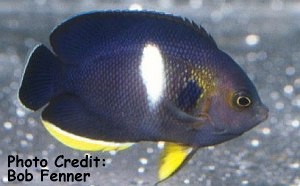
By Bob Goemans

Likely Reef Tank Suitable
Likely Fish-Only Tank Suitable
Range: Western Pacific Ocean: Japan to Australia and the Solomon Islands to New Caledonia
Size: 7 inches (17 cm)
Natural Environment: Inhabits shallow lagoons where rubble and corals provide numerous hiding areas at a depth of 10 to 100 feet deep (3 – 30 m) and mainly feeds on algae. Generally exists in small groups and is one of the largest Centropyge species.
General Husbandry: This quite hardy and beautiful dwarf angelfish has a black body with a white vertical bar, and its anal and pelvic fins are yellow. As it ages, the dorsal and tail fins acquire a thin blue edging.
Its recommended this species be added to a well-established reef or fish-only aquarium, as it likes to pick on rocks containing various forms of algae or find accumulations of detritus to ingest. In fact, its an excellent browser of filamentous algae, and will also accept a wide variety of frozen foods including fortified brine shrimp, mysis, and flake food, especially Spirulina. Two feedings per day is highly recommended. Its also recommended there be only one species from this dwarf angelfish genus in the aquarium, as they tend to develop aggression toward other dwarf angelfish. Its also recommended it be the last fish to be added as it can be quite feisty with newcomers.
Nevertheless, it can be quite shy when first entering the aquarium, and will hide in caves and crevices. But as time passes, will become more outgoing and begin to establish its territory. Not suited for small nano style aquariums, as they will not only become very aggressive in small aquariums, they will, without numerous feedings per day, be able to find enough food to be maintained long-term.
Taxonomy:
Order: Perciformes
Suborder: Percoidei
Family: Pomacanthidae
Genus: Centropyge
FYI: All Centropyge species start life as unsexed individuals, but begin their adult life as females. Then, the larger or more dominant individual within small groups will change sex within a few days to a couple of weeks and become a male. Knowing that size is the main difference between the sexes, and not so much its coloration, all one needs to do is place a small and larger specimen together. Within approximately sixty days one of the two fish will have physically changed sex to accommodate the other. A reversal of this sex change is possible if the need arises, but that requires much more time, e.g., weeks to months.
Keep in mind all angels have cheekspines at the edge of their gill cover; therefore use caution when handling and also avoid using a net to capture it, as it may become stuck or tangled in the net and become damaged when removed.
Females are quite black, whereas males are dark blue.
Experience Level: Intermediate
Temperament: Semi-aggressive
Diet: Omnivore
Acclimation Time: 30 minutes+
Aquarium Environment: Reef aquarium (see below) or fish-only aquarium
Reef Safe: With caution – has a tendency to nip clam mantles, large–polyped stony (LPS) corals and some soft corals, especially so when underfed.
Minimum Tank Size: 70 gallons
Temperature Range: 72 - 82°F (22 – 27°C).
Specific Gravity: 1.020-1.027
pH: 8.0 - 8.5
